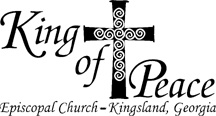The difficult, intractable, concreteness of forgiveness
In tomorrow's Gospel reading, Jesus appears to his disciples after his resurrection. Luke's Gospel tells us,
While the disciples were telling how they had seen Jesus risen from the dead, Jesus himself stood among them and said to them, "Peace be with you." They were startled and terrified, and thought that they were seeing a ghost. He said to them, "Why are you frightened, and why do doubts arise in your hearts? Look at my hands and my feet; see that it is I myself. Touch me and see; for a ghost does not have flesh and bones as you see that I have." And when he had said this, he showed them his hands and his feet. While in their joy they were disbelieving and still wondering, he said to them, "Have you anything here to eat?" They gave him a piece of broiled fish, and he took it and ate in their presence.In a Reflection for Day One, the Rev. Benjamin Anthony writes,
Jesus invites them to "touch and see" that he has the flesh and bones of a real body and not the pseudo-substance of a ghost. Though joyful, the disciples continue to disbelieve and wonder: uncertain of what it means to embrace a body that has passed through the hellishness of violence, the utter isolation of death and risen into endlessness of God's life.The full text of the reflection is online here: Folding Screens and Forgiveness.And then he eats a piece of broiled fish. A human act and the very gross sort of material, physical act that is required of embodied existence. Eating the piece of fish could be construed as proof that the risen Jesus was not a ghost and simply left at that. Or we could see this act as the eternal and risen Jesus offering a simple demonstration of the body's profound significance. To be human is to have a body and to have a body is to eat, to hurt, to feel pleasure and to experience lack.
Jesus gestures to his wounds and then eats the piece of broiled fish. To be human and to have a body is to be vulnerable, liable to death and yet made for the endlessness of God's life. The crucified and risen Jesus knocks down the folding screen that we have set up to curtain off death.
In the presence of the risen Jesus, the disciples--and we along with them--find that our minds are being opened up to receive the truth disclosed in scripture. In the presence of the risen Jesus, the body's holiness is disclosed, the threat of death is evacuated of its force, and we begin to see that these and every promise of God begins in repentance and forgiveness of sins.This is the truth of scripture and its trajectory will not be complete until it has been "proclaimed in [Jesus'] name to all nations, beginning from Jerusalem." Which is to say, proclaimed to everyone, everywhere. A universally redemptive sweep that begins in the particular tissues of concrete events, in the lives of real people with real bodies and real wounds. The crucified and risen Jesus discloses the difficult, intractable concreteness of forgiveness: a forgiveness that begins wherever human judgment excludes and destroys. A forgiveness that must begin "in Jerusalem" and radiate outward, confronting the sins and violence of every nation.
Labels: Gospel reading







0 Comments:
Post a Comment
<< Home